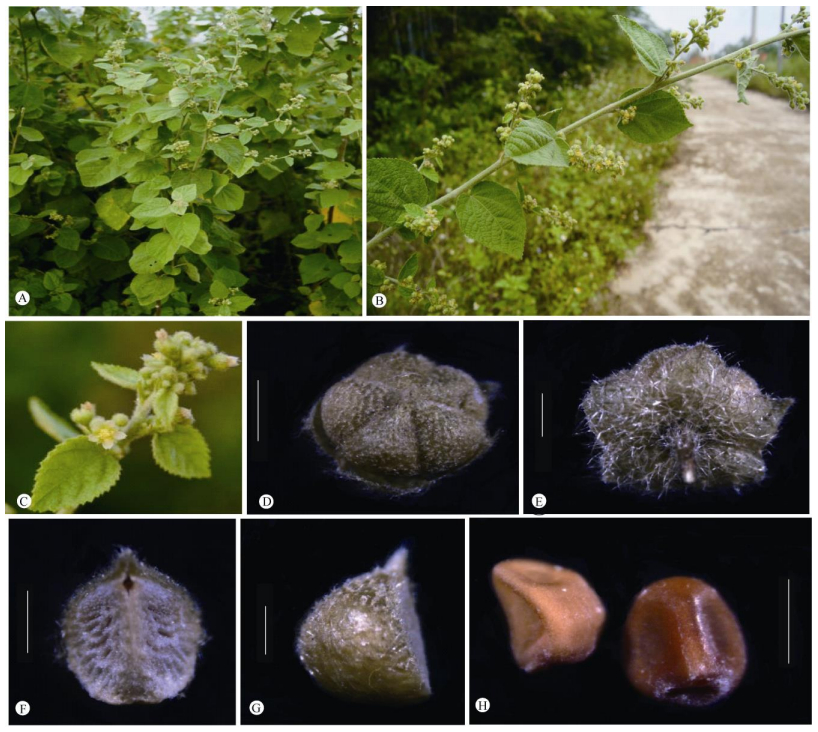2. 广东湛江红树林国家级自然保护区管理局, 广东 湛江 524088;
3. 中国科学院华南植物园, 中国科学院植物资源保护与可持续利用重点实验室, 广州 510650
2. Administration Bureau of Zhanjiang Mangrove National Nature Reserve, Zhanjiang 524088, Guangdong, China;
3. Key Laboratory of Plant Resources Conservation and Sustainable Utilization, South China Botanical Garden, Chinese Academy of Sciences, Guangzhou 510650, China
During the course of investigating the mangrove plants in Guangdong, we found a unique plant of Malvaceae that have never been reported from China before[1-2]. Further studies reveal that it represents a newly recorded genus, Sidastrum Baker f., from China.
Malvaceae is a widespread family comprising about 243 genera and 4225 species, distributed mainly in tropical areas[3-4]; 19 genera (four introduced) and 81 species (24 endemic, 16 introduced) in China[2].
The genus Sidastrum belongs to tribe Malveae in subfamily Malvoideae[3-4]. It was separated from the genus Sida L. by Baker[5] with single species S. quinquenervium (Duchass. ex Planch. & Triana) Baker f. Subsequently, Fryxell[6] transferred several neotropical species from Sida to Sidastrum. It consists of about seven species in the family Malvaceae and is distributed in Mexico, Indies, Central America, South America and Africa[5]. There are probably also numerous others Australian and Oceanian species currently placed in Sida merit to be transferred to Sidastrum[5]. The differences between Sidastrum and Sida are given as below:
1. Calyx 10-costate at base; mericarps indurate················ Sida
1. Calyx without costate; mericarps relatively fragile········· ····························································· Sidastrum
Sidastrum Baker f. J. Bot. 30(353): 137. 1892. Type: Sidastrum quinquenervium (Duchass. ex Triana & Planch.) Baker f. (=Sida quinquenervium Duchass. ex Triana & Planch.) 沙稔属(新拟)
Erect subshrubs 1-2 m tall, more or less stellate-pubescent. Leaves spirally arranged, petiolate or subsessile; stipules persistent, subulate; blade ovate or lanceolate, rarely elliptic, not dissected or parted, base truncate or subcordate, rarely rounded, margins dentate, serrate or crenate, surfaces stellate-hairy. Inflorescences of terminal panicles, rarely racemes or reduced to flower solitary; involucel absent. Pedicels long or short, sometimes capillary, the individual pedicels sometimes subtended by 3 stipuliform bracteoles; calyx small, cupuliform, ecostate, 5-lobed; petals small, white, yellow, or orange, rarely rose or purple; androecium included, filamentiferous at apex, the anthers 5-20; styles 5(-10), slender, the stigmas capitellate. Fruits schizocarpic, oblate to conical, often stellate-hairy, smooth or weakly reticulate; mericarps 5(-10), essentially indehiscent, trigonal, smooth, or somewhat reticulate laterally. Seeds 1 per mericarp, glabrous or subglabrous, sparsely hairy. 2n=32.
The genus consists of about 7 species distributed in Mexico, West Indies, Central America, South America, Africa. Recently, one species is found in Guangdong, China.
Sidastrum micranthum (A. St.-Hil.) Fryxell, Brittonia 30(4): 452. 1978. Sida micrantha A. St.-Hil., Fl. Bras. Merid. 1: 190. 1827. 小花沙稔(新拟) Fig. 1

|
Fig. 1 Sidastrum micranthum (A. St.-Hil.) Fryxell. A: Habitat; B: Plant; C: Inflorescence; D: Top view of fruit; E: Bottom view of fruit; F: Lateral view of mericarp; G: Ventral view of mericarp; H: Seeds. Bars=1 mm |
Erect shrub, 2-3 m high. Stem to 4 cm in diameter at base, densely pubescent with stiff minute stellate hairs. Leaves ovate, 9.2-10.3 cm×3.5-5.5 cm, base cordate, margin crenate, apex acute to acuminate, 5-9-nerved from the base, densely stellate-tomentose on both surfaces; petiole 1.5-6.5 cm long, stellate-hairy; stipule linear, 6-10 mm long, hairy. Flowers axillary, condensed racemes or panicles; pedicel 3-6 mm long. Calyx 1.5-2 mm long, campanulate, 5-lobed; lobes acute at apex, stellate-hairy outside. Corolla exceeding the calyx, off-white, glabrous; petals obovate, 1.5-2.2 mm×0.8-1.2 mm. Staminal column 2-3 mm long, antheriferous towards apex, sparsely stellate-hairy. Ovary pentacarpellary, hairy; style 1-2 mm long, glabrous; stigmas 5. Mericarps 5, 2.8-3.2 mm×1.5-1.8 mm, longer than persistent calyx, trigonous with acute angles, pale yellow when mature, faintly transversely rugose on sides and stellate-hairy on back, thin-walled; beaks 2, much shorter than mericarp, stellate-hairy; mericarp one seeded, indehiscent. Seed ovoid, 1.4-1.6 mm×1.0-1.2 mm, trigonous, glabrous, blackish. Fl. Oct.-Jan. 2n=32[7].
Distribution and habitat. Sida strum micranthum is native in Brazil, Colombia, Costa Rica, Cuba, Guiana and Venezuela[8]. Recently, it was found to be naturalized in India[6]. It is newly recorded from China and occurs in Guangdong. In China, this species was found in the open, wasted land near the coast, and it is probably a recent introduction through imported seeds or food grains.
Specimens examined. China (中国), Guang-dong (广东): Leizhou Shi (雷州市), Kelu Zhen (客路镇), on the grass, roadside, alt. 12 m, 2015-11-20, Lin Guang-xuan & Wang Qing-long 1120045.
Uses. It was reported to be used to treat bronchitis, cough, and asthma in Brazil. The leaves are also used as cataplasms (poultices), with hot butter and olive oil, as a moisturizing agent[9].
| [1] | QIU H X. Malvaceae [M]//Flora of Guangdong, Volume 2. Guangdong: Science and Technology Press, 1991: 180-204. (in Chinese) |
| [2] | TANG Y, GILBERT M G, DORR L J. Malvaceae [M]//Flora of China, Volume 12. Beijing: Science Press & St. Louis: Missouri Botanical Garden Press, 2007: 264-298. |
| [3] | BAYER C, KUBITZKI K. Malvaceae [M]//The Families and Genera of Vascular Plants, Volume 5. Berlin: Springer, 2003: 225-311. |
| [4] | AGUILAR J F, FRYXELL P A, JANSEN R K. Phylogenetic rela-tionships and classification of the Sida generic Alliance (Malvaceae)[J]. Syst Bot, 2003, 28(2): 352-364. |
| [5] | BAKER E G. Synopsis of genera and species of Malvaceae[J]. J Bot, 1892, 30(353): 137-138. |
| [6] | FRYXELL P A. The American genera of Malvaceae: Ⅱ. Brittonia [J]. 1997, 49(2): 204-269. |
| [7] | SHIMPALE V B, SUTAR S P, YADAV S R. Sidastrum(Malvaceae): A new genus record for Asia[J]. Rheedea, 2009, 19(1/2): 50-52. |
| [8] | BOVINI M G, CARVALHO-OKANO R M, VIEIRA M F. Malvaceae A. Juss. no Parque Estadual do Rio Doce, Minas Gerais, Brasil[J]. Rodriguésia, 2001, 52(81): 17-47. |
| [9] | AGRA M F, BARACHO G S, BASÍLIO I J D, et al. Sinopse da flora medicinal do cariri paraibano[J]. Oecol Bras, 2007, 11(3): 323-330. DOI:10.4257/oeco |
 2017, Vol. 25
2017, Vol. 25
